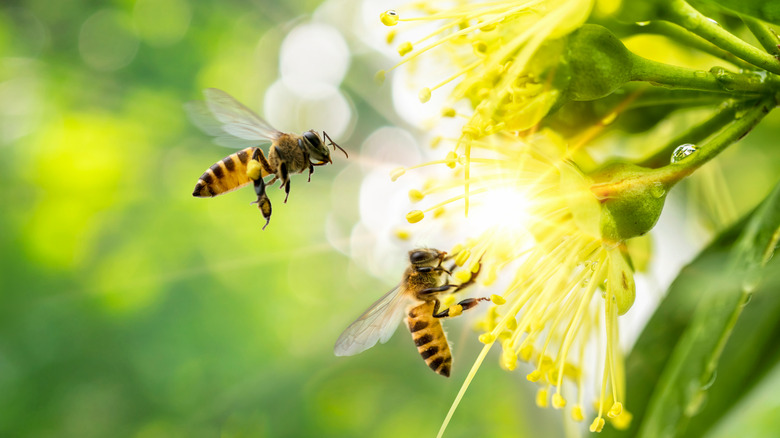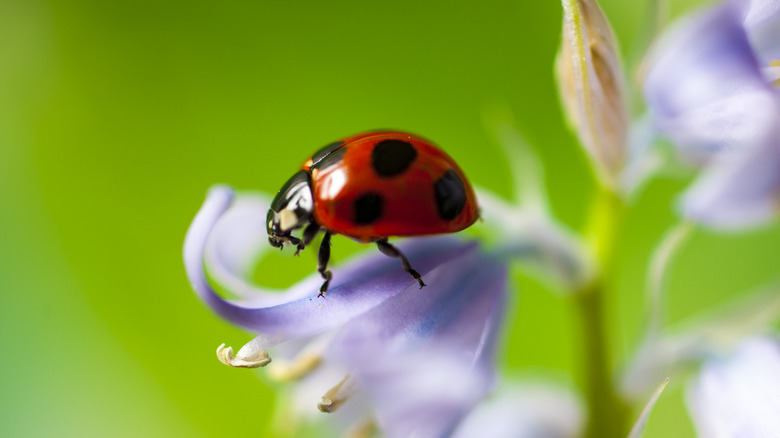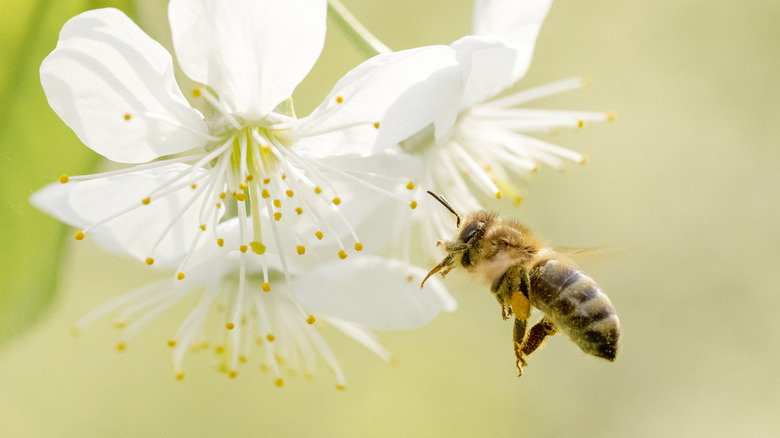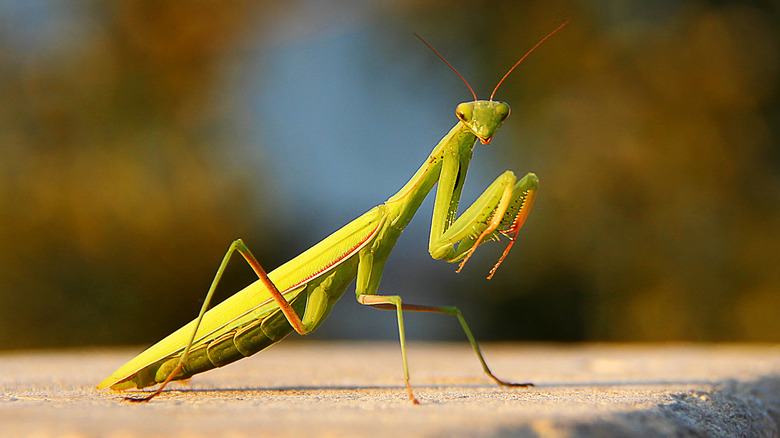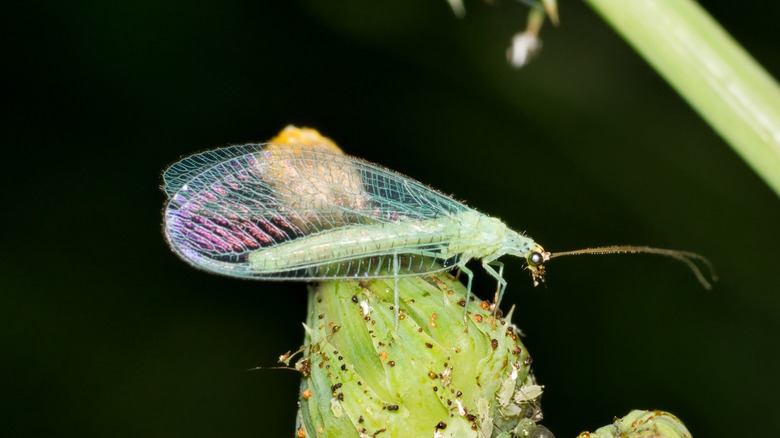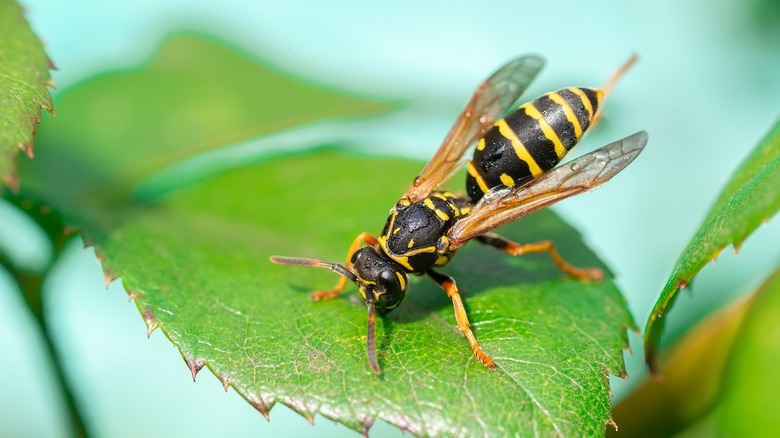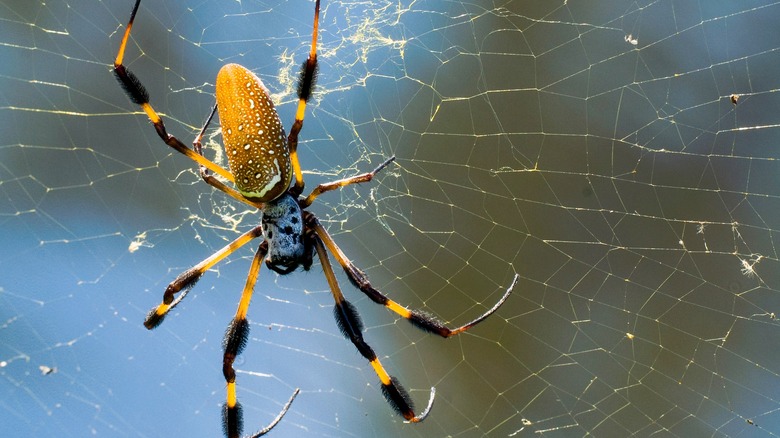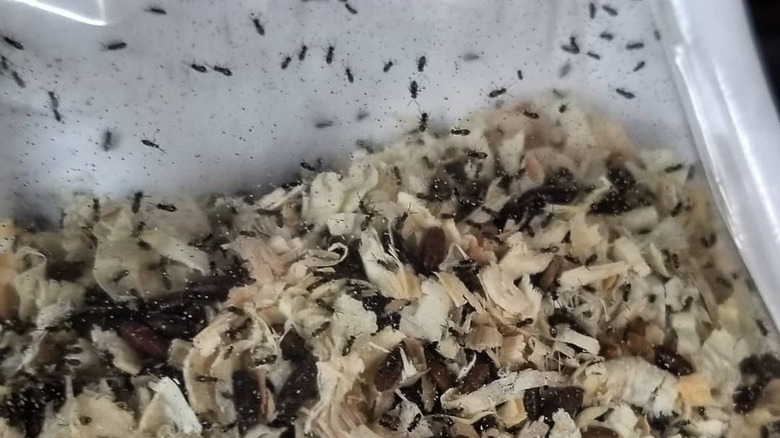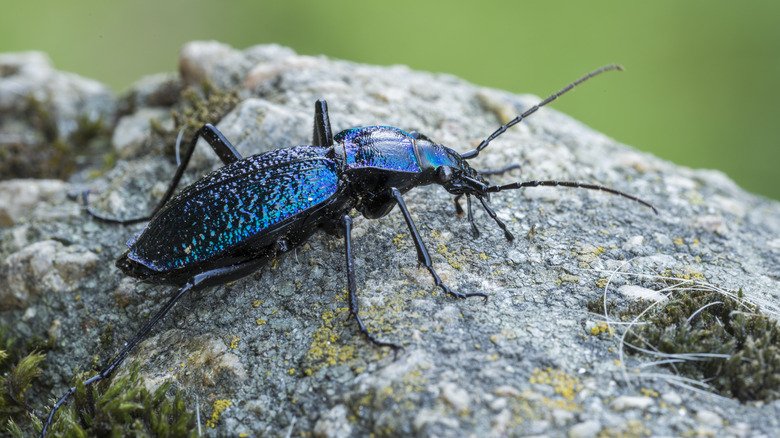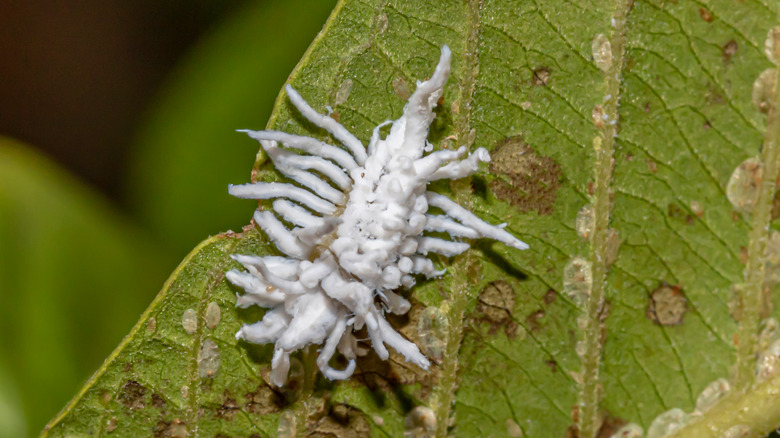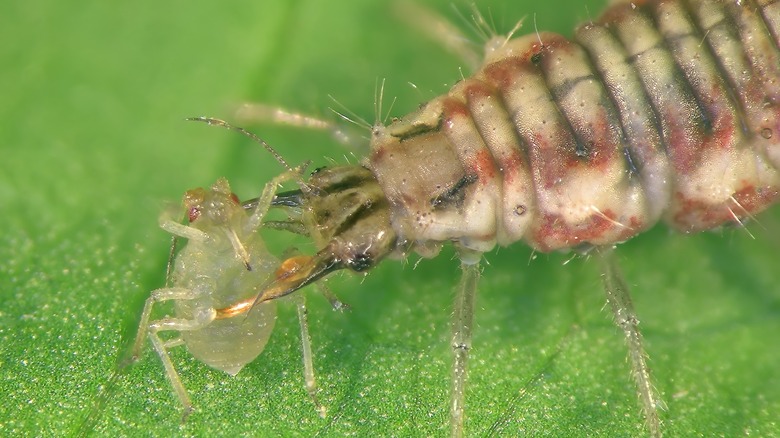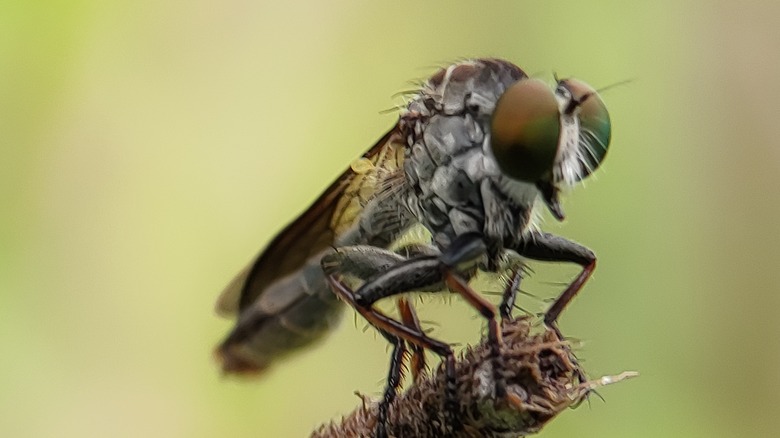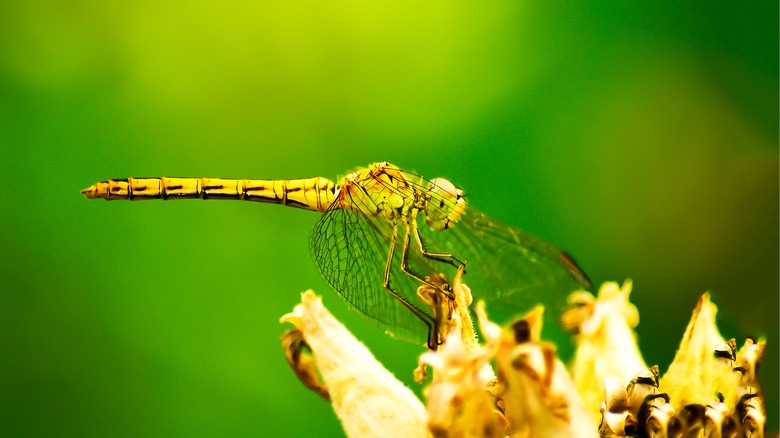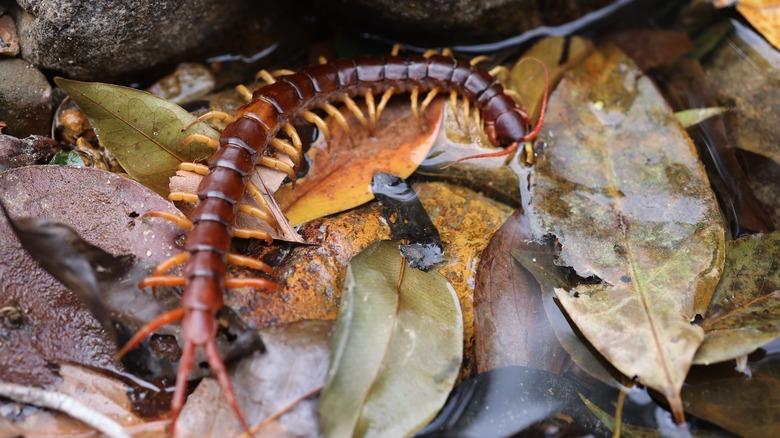Think Twice Before Killing These Insects In Your Garden
When it comes to bugs in the garden, most people's natural instinct might be to get rid of them all! Insects need to be stopped, at all costs, from eating flowers and the beautiful bounty of the vegetable garden. However, think twice before applying any "kill-all" insecticide. While it is true that there are plenty of insects that are pests of the highest order, there is an equal amount that is the exact opposite.
There are many species of insects that are actually beneficial to gardens, orchards, and flower beds. The Old Farmer's Almanac splits these beneficial bugs into three categories: predators, pollinators, and parasitizers. Predators are those insects which prey upon pests by eating them. Pollinators feed on nectar and pollen, which are essential for plant pollination. Meanwhile, parasitizers like to infect areas with pests by laying their parasitic eggs alongside those of the pests. Once the parasite eggs hatch, they feast upon the pest larvae.
That last one may sound gruesome, but it is all part of the ecosystem of the garden. And while some of the insects on this list are going to look aggressive and scary, they are all serving a higher purpose. That purpose is that the less pest-populated your garden is, the better it will be for you.
Ladybugs
Ladybugs are a welcome sight in any garden. Considered to be bringers of good luck, many think that ladybugs are doing nothing more than serving as a friendly insect companion with a really cool exoskeleton. Ladybugs do much more than that, however. They may not look it, but ladybugs are actually one of the insect world's apex predators.
Ladybugs absolutely love to feast upon aphids, which are these annoying, tiny green insects that can destroy anything from tomatoes to cabbage. According to NC Cooperative Extension, aphids feed by sucking sap out of the plant through the underside of its leaves. Because they feast on aphids in their larval stage and when fully grown, ladybugs make out to be a gardener's ally. They are even available to be purchased commercially; that's how much people love to have these bugs in their garden.
On average, ladybugs will eat between 50 to 60 aphids in a single day (via Buglogical Control Systems). So, assuming the presence of several thousand aphids, coupled with a hundred ladybugs, that is a consumption of 5,000 to 6,000 aphids a day. And that's not the only pest ladybugs will eat. They'll also consume mites, mealy bugs, scales, and other types of soft bodied insects.
Honey bees
Honey bees are the most iconic of all pollinators and should be welcomed in any garden. Especially beneficial to flowering plants and fruit trees, honey bees will consume nectar and collect pollen. They will then fly around, spread pollen across the garden, and return to their hives to make delicious honey. They are an all-together fantastic package, which is why people have been beekeeping for over 9,000 years (via BBC).
Pollination is incredibly beneficial because it encourages the overall health of the garden. Regardless of whether or not vegetables are being grown for consumption or flowers for aesthetics, having honey bees around to pollinate plants is only going to be a benefit. And honey bees aren't the only buzzers welcome in the garden.
Bumblebees and other species will help pollinate numerous different plants, adding to the biodiversity of your yard. It is also worth noting that just because bees have the ability to bite and sting, it doesn't mean that they will. Though the buzzing of bees may elicit fear, especially from those who are allergic to their sting, it is very easy to call in professionals to have beehives relocated. Thankfully, most bees are not outwardly aggressive and will only sting if they feel threatened. Being polite to bees is a small price to pay in exchange for all of the good that they do.
Praying mantis
It's difficult to think of an insect that looks cooler than the praying mantis. As its name suggests, the praying mantis is a predator of the highest order. Its powerful, spiky front legs have the speed and force to lash out and catch almost any insect. Plus, praying mantis are not remotely picky about what they eat. This includes potential mates. Fella mantises, be warned. Though it is relatively rare, the female praying mantis has been known to consume her male partner following copulation.
Both genders of praying mantis will eat some of the most common garden pests around. This includes beetles, grasshoppers, caterpillars, harmful wasps, moths, nematodes, and even small mammals like birds and mice. Naturally, you don't want the mantises to be eating other beneficial insects, which has been known to happen. However, no one would be upset to see one taking out that mouse that's been nibbling on the zucchini.
Think of the praying mantis as the vanguard of natural garden defense. Far from desiring to get rid of them, praying mantises should be an encouraged member of the garden ecosystem. Their presence is going to do far more good than harm.
Lacewings
The green lacewing provides a double-fronted benefit. It can be both predator and pollinator. As adults, these wide-winged insects act a lot like honey and bumblebees do. They feed on the pollen and nectar of plants, then proceed to share that pollen among the other plants, helping to create that healthy biodiversity that is so essential for the garden and the wider ecosystem.
On the predatory front, the green lacewing is a top-tier aphid eater. In their larval stage, green lacewings can eat upwards of 200 aphids in a single week (via Birds and Blooms). Once they have undergone their chrysalis transformation into adulthood, the green lacewing will continue to feast on the aphid eggs it finds on the underside of leaves.
Though they may look somewhat creepy depending upon your bug inclinations, green lacewings don't do anything more aggravating than flying around people's heads every so often. As such, because they are so good at eating aphids and have such excellent pollinator capabilities, they should be a welcome sight in vegetable gardens, flower beds, and fruit orchards.
Wasps
There are certainly some wasps whose presence is unwelcome. While all wasps have the capacity to be aggressive and inflict harmful stings, there is a major difference between solitary wasps and social wasps. Identifying which are which easily by noting how they interact with other wasps. Generally, it is the solitary wasp wanted in the garden. They are much less likely to sting and want to avoid human interaction whenever possible.
Instead, these solitary wasps will go after some of the most common garden pests. They will eat aphids, caterpillars, and other soft-bodied insects. There are even parasitic wasps that infect the nests of the more pestilential bugs, allowing their larvae to feast on the unwary aphids or other pests.
The wasps who should be welcomed to the garden are ones like paper wasps, cicada killers, yellow jackets, and European hornets. Remember, in general, they will not bother anyone as long as they are not being bothered. If someone truly wants them gone, they can call in a removal specialist. This is preferred over using insecticide. The wasps will be welcomed somewhere else.
Spiders
Spiders get a bad rep. No, really, they do. Though they look scary, and some of them have the ability to inflict serious harm, the vast majority of spiders want absolutely nothing to do with humans. They much prefer to feast upon the types of insects that everyone finds particularly pestilential. Therefore, spiders in the garden ought to be considered an extreme benefit.
Though technically arachnids and not insects, nearly everyone lumps spiders in with bugs. In the garden, spiders can play an amazing role in controlling the pest population. They are not interested in eating your vegetables because all spiders are carnivorous. Therefore, they will be eating the likes of aphids, mosquitoes, flies, caterpillars, and even rodents in some instances. All of the benefits that spiders bring to the garden might not be seen, but their presence can make for a garden with a lot fewer mosquitoes, and who doesn't want that?
So, if a spider has woven its web in the rose bushes or between tomato vines, leave it alone. Until harvesting season, these critters should be as welcome as a favorite family member and, therefore, not disturbed.
Fly predator
Up close, fly predators look rather waspish and cruel in their appearance. However, this is one bug where its looks are totally deceiving. Fly predators are not remotely harmful to humans, or other animals for that matter. Instead, they feast on one of the most annoying insects on the face of the planet: pest flies.
Fly predators go specifically after the larvae of pest flies. However, they don't go about it in the way you might think. While they will eat fly larvae in their adulthood, female fly predators consume pest flies by means of parasitic invasion (via The Cheshire Horse). They drill a hole into the cocoon of the pest fly pupa and lay their eggs inside. Once hatched, the fly predator larvae will consume the pupa. It sounds incredibly gruesome, but the benefits are extremely high.
Many who grow gardens will steward animals as well. Whether it's pigs, cows, horses, or chickens, having fly predators around means that there are going to be fewer flies to deal with, which will be beneficial for the stress levels of the animals and the gardener. Fly predators love to target manure piles, which are havens for files and maggots. The fewer flies there are, the easier it will be to be outside.
Ground beetles
Ground beetles is an all encompassing term for a large group of predatory beetles, all of whom are beneficial to the garden landscape. Their ranks include the likes of the bembidion, pterostichus, carabus, harpalus, and amara beetles. They pose absolutely no threat to food grown in gardens, the people who garden, or any kind of structure built in said garden. Instead, they are interested in only one thing: eating pests.
Ground beetles are hungry critters, and they are able to eat their fill by having an incredibly diverse diet. They will eat all of the following: caterpillars, nematodes, slugs, silverfish, weevils, and flies. One downside is that, depending on their size, ground beetles can sometimes be at risk of being eaten by others of their kind. This can end up being a problem for pest control. Overall, however, ground beetles serve as an asset as opposed to a problem.
Identifying ground beetles can be a little tricky, as they all look somewhat similar to one another. Ground beetles are typically brown, black, or metallic in sheen, though there are those that have more colorful presentations. They are typically flat, have large abdomens, and narrow heads with long antennae. They will also have pretty defined mandibles, which are what makes them so good at eating so many pests. So, make sure to identify what kind of beetle it is before deciding to crush it.
Mealybug destroyer
There are not many people who believe that bringing in species from other countries is good for native populations. However, there have been some instances where it has worked out quite well. Such is the case with the mealybug destroyer. Originally brought to the United States by way of Australia, these small, predatory beetles have been used as a biological control for over 100 years (via Plant Natural Research Center). This is because they eat one thing very well: citrus mealybugs.
The scourge of a citrus grower's existence, citrus mealybugs will feast on the fruit and leaves of citrus trees, bringing with them disease and rot. Mealybug destroyers can help curb mealybug populations without the need to resort to chemicals. The destroyers go after the mealybugs in two stages: as larvae and as adults. Destroyer larvae look an awful lot like actual mealybugs, but only destroyer larvae are covered in white tendrils that make them look rather like aliens. As adults, mealybug destroyers look more like small ladybugs, but with no spots.
Though they were initially brought to control citrus mealybugs, the mealybug destroyer will eat all species of mealybugs and other soft-bodied insect pests, such as small caterpillars and aphids. Like ladybugs, mealybug destroyers can be purchased commercially and fostered in the garden. They only need to be bought once because these insects will thrive very well on their own.
Aphid predator
Also known as the aphid or gall midge, these small insects will do the job of controlling your aphid population in a jiffy. The problem arises not so much in their larval stage but when they become adults. See, adult aphid predators are mildly representative of mosquitoes. The only difference in their looks, really, is the fact that they don't have needle noses and instead have long, curling antennae. Unfortunately, this difference might not be noticed until the aphid predator is already crushed.
Still, it is the larvae of the aphid predator that do the most work. Noted for their bright orange color, the larvae of the aphid predator will eat over 60 different types of aphids and do so with lightning speed (via Planet Natural Research Center). They will take care of aphids faster than ladybugs and green lacewings combined, making for a really excellent midge to have in the garden.
Feeding primarily at night, the aphid predator larvae will stay in that stage for roughly two weeks before transforming into adults. The adults will then lay more eggs, and the cycle of aphid control continues.
Robber flies
Outwardly appearing to be the cross between a horsefly and a mosquito, robber flies are extremely important to the overall garden ecosystem. Because they are so indiscriminate when it comes to hunting down prey, having them around is a double-edged sword. While the robber flies will take care of a lot of garden pests, they will also kill and eat some of the more beneficial insects like dragonflies and ladybugs. Regardless, the robber fly remains a well-known biological control for pests.
Unlike horseflies, robber flies do not attack humans. Instead, they will use that aggression to take out pest flies, grasshoppers, Japanese beetles, caterpillars, moths, and others. In their larval stage, the robber fly will eat a number of other soft-bodied insects, such as aphids, wireworms, beetle larvae, and grubs.
So, while they are generalist hunters as opposed to targeting specific prey, robber flies will generally do more good than harm as far as pest management is concerned. Just don't be put off by their looks. They are here to help!
Dragonflies
Let's face it: if there is one insect that can compete with the praying mantis in the looks department, it is the dragonfly. More than having mere looks on their side, dragonflies are considered by many to be the best insect hunters in all of nature. And unlike their robber fly cousins, dragonflies are able to strike a perfect balance between consuming beneficial insects, and those that are considered to be pests.
Dragonflies will eat lots of other flying insects, such as biting flies or gnats, mayflies, and especially mosquitoes. These bloodsuckers are a particular favorite of dragonflies. Alongside spiders, dragonflies are among the best natural defenses against mosquitoes. So, they should really be welcomed into the garden with open arms.
Since dragonflies lay their larvae in the water, adding a small water feature to your garden is going to be a great way to invite these majestic insects into your yard. And don't worry about the fact that mosquitoes lay their eggs in water, too. Dragonfly larvae eat the same diet they do as adults. So, regardless of their stage in life, they make for excellent mosquito killers.
Centipedes
Though all of the insects on this list have been either predators, parasites, or pollinators, there is still one more insect that plays an equally vital role in the garden: the decomposer. Centipedes may look totally terrifying with their countless legs, pincers, and slime bodies, but they will help the garden in the breaking down of organic matter. As a result, the garden's soil gets fed with the nutrients of the broken-down organic matter, leading to overall better health.
Centipedes are also carnivores, making them another great predator to have in the garden. As nocturnal hunters, centipedes tend to go after those pests that are also out and about during the nighttime. These include silverfish, moths, spiders, crickets, and cockroaches. So, along with them aiding in the regeneration of your soil, they are also taking care of some common garden pests for you. However, the fewer spiders they eat, the better.
Not everyone is going to be fond of having insects of any kind in their garden. However, bugs are something everyone has to live with. They are a part of nature, the same as humans are. And the more beneficial insects that are roaming around in the garden, the healthier it will be. Which, at the end of the day, is what we all want.
